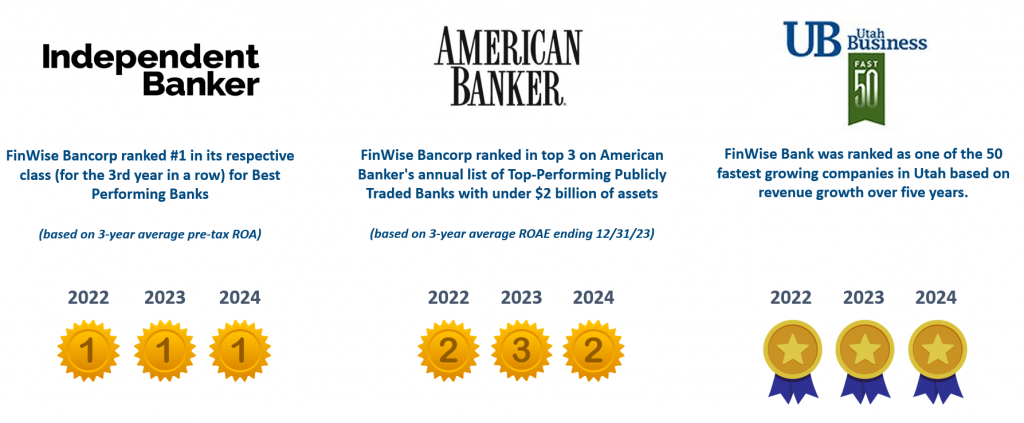The October 2025 edition of FinWise Insights focuses on innovation, compliance, and the future of financial services. It highlights key industry trends in lending, automation, and embedded finance, explores advanced credit modeling techniques, and introduces the concept of programmable money as a transformative force in banking. With expert insights from FinWise leaders and strategic partners, this issue provides actionable perspectives for fintechs, banks, and businesses navigating a rapidly evolving financial ecosystem.
In particular, we cover:
- 2025 Lending Trends: Automation, Embedded Finance, and Economic Shifts
- Beyond the Score: How Smarter Models Are Shaping the Future of Lending
- The Programmability of Money: Unlocking the Future of Finance
Ready to Fly with FinWise? 🦉
News recap.
- Latest Podcast(s)
- Enhancing Corporate Payments with Strategic Innovation with Alex Jimenez from Backbase
- Exploring Fintech Innovations: From Stablecoins to Venture Investments with Tom Brown from Paul Hastings
- Navigating Fintech Growth: Compliance, Partnerships & the Regulatory Landscape with FS Vector’s Trevor Tanifum
- News from FinWise
- FinWise is at Money20/20 USA! We’re excited to connect with fellow innovators, bankers, and fintech leaders as we dive into the future of financial services. Bank and Fintech executives, be sure and stop by our onsite recording of the FinWise EYE ON Fintech Podcast in the Canaletto Restaurant and share with our listeners your take on what’s hot at the conference. We’re looking forward to an energizing week of ideas, partnerships, and activation. Looking forward to seeing you there!
2025 Lending Trends: Automation, Embedded Finance, and Economic Shifts.
Chris Comber
SVP, Credit Management & Strategy
at FinWise Bank
As we enter the final quarter of 2025, we analyze trends that have set the tone for lending in the 2025 fiscal year. Several key trends that have shaped the lending environment in recent history have been driven by evolving macroeconomic conditions, advancements in technology, and a shifting regulatory environment. AI-powered automation, rise of embedded financing, and volatility in interest rates were among the most influential factors across consumer, small business and commercial lending sectors.
Technology & Automation Trends
Lenders have been increasingly adopting AI to improve current risk management processes, fraud detection, in addition to real-time risk assessments. In this large-scale adoption, challenges remain including data privacy, regulatory compliance, and the underlying risk of bias in AI models. Even with apparent risks and little comprehensive AI regulation as it relates to the banking industry, regulators expect banks to use a risk-based approach with existing laws and principles, ensuring AI applications are safe, fair, and transparent. The regulatory landscape is evolving, with various agencies issuing guidance, analyzing risks, and beginning to address AI-specific concerns.
After acknowledging potential risks and regulatory interpretations, the financial service industry is quickly working to adopt forms of AI as a focus of both cost reduction and revenue growth. It was estimated in a report from Acrew Capital and Money 20/20 that 76% of Financial Services companies have launched AI initiatives. Such companies such as Upstart, a Strategic Partner of FinWise Bank, have long been on the bandwagon of adopting AI to support their lending platform.
Upstart is an online lending platform founded in 2012 that uses AI to connect borrowers with over 100 banks and credit unions for personal loans, ranging from $1,000 to $50,000. The lending platform uses AI and machine learning to leverage a wider range of data points than traditional credit models. The alternative data currently encompasses 1,600 data points to create a holistic borrower profile, including factors such as education, employment history, and financial behaviors. The AI is then implemented to identify creditworthy applicants who might be rejected by traditional models. In some analysis, this has led to a higher rate of approvals and lower average interest rates for borrowers.
In addition to large scale adoption of AI molding the forefront of fintech innovation is the growing popularity of embedded financing.
Read more on 2025 Lending Trends >
Beyond the Score: How Smarter Models Are Shaping the Future of Lending.
Simon Darchis
SVP, Head of Fintech Products and Strategic Initiatives
at FinWise Bank
For decades, the FICO score has been the gatekeeper to financial opportunity—determining who qualifies for a loan, at what price, and on what terms. Yet, as the fintech landscape evolves, it’s clear that the future of lending is being built on a richer, more nuanced understanding of consumers.
Today’s lenders are moving beyond snapshots to assemble a mosaic—a multidimensional picture of each borrower. This shift is powered by new technologies, diverse data streams, and a growing commitment to ethical engagement, especially for those outside the traditional credit system.
Moving Beyond, FICO
Millions of Americans—often called “credit invisibles”—lack the lengthy credit histories needed for reliable bureau scores. These individuals may have steady incomes, college degrees, and even own homes, but volatile incomes and limited savings make them vulnerable to unexpected expenses. Traditional metrics often miss this nuance.
Forward-thinking institutions like FinWise and their partners are embracing alternative approaches. One of the most promising is the use of bank transaction data. By analyzing how consumers manage their checking accounts—the rhythm of deposits and withdrawals, recurring bills, and overdraft patterns—lenders gain real-time insight into financial behavior. Research, including a 2021 Federal Reserve study and recent CFPB reports, shows that transaction-level cash flow data can significantly improve the predictive power of credit models compared to bureau data alone.
The Alliance for Financial Inclusion (AFI) highlights how non-traditional data sources—such as utility payments, social media insights, and behavioral patterns—are revolutionizing credit assessment for underserved populations. Regulatory frameworks from 32 AFI member countries are advancing access to finance for those previously excluded from traditional credit systems.
The result? Better underwriting and broader inclusion. More borrowers can access loans when they need them most, creating a “prime experience for non-prime consumers.”
Read more about shaping the future of lending >
Product Spotlight.
Max Egert,
Fintech Product Manager
at FinWise Bank
The Programmability of Money: Unlocking the Future of Finance
Stablecoin is probably as buzzy of a word in 2025 as Artificial Intelligence was in 2024. We’re always looking to stay at the forefront of emerging trends in Banking to help guide us in our future product development. An area of development that has been brewing since it was trendy to talk about stablecoins was the programmability of money.
Money has always carried a degree of programmability, although in limited ways. Postdated checks, payroll direct deposits, and recurring bill payments are examples of embedding rules into financial flows. These were early attempts at making money “behave” in predictable ways.
Today, programmability is moving into a new era. With the rise of smart contracts, stablecoins, and enhanced features in traditional payment infrastructure, money itself is becoming programmable in code. This is more than a technical improvement. It represents a fundamental shift in how financial institutions, fintech’s, and enterprises design products, manage trust, and automate financial processes.
Programmability makes money more than just a medium of exchange. It transforms it into a platform for innovation.
Smart Contracts: Code as the New Agreement.
Smart contracts are digital agreements that automatically execute once predefined conditions are met. Instead of relying on manual processes, reconciliation, or intermediaries, these agreements run directly on code. For instance, Smart contracts could be used in the following use cases:
- Insurance: Claims can be paid the moment an event is verified, such as flight delays or vehicle damage.
- Freight: Payment is provided automatically to the shipper of goods upon the Bill of Lading being issued. The Bill of Lading would then be automatically provided to the shipper upon payment execution.
The result is greater efficiency, fewer errors, and less reliance on intermediaries. For financial institutions, this also unlocks entirely new categories of products that settle in real time while embedding compliance checks and reporting obligations directly into the transaction.
Stablecoins: Stability Meets Programmability.
Cryptocurrencies introduced programmability but carried the challenge of volatility. Stablecoins address this by pegging digital tokens to fiat currencies, combining price stability with the flexibility of blockchain-based money.
The implications are significant, for instance, stablecoin smart contracts could be used for:
- Corporate treasury management: Idle funds can be automatically swept into yield-bearing accounts or settlement pools in real time based on current capital conditions, allowing treasurers to maximize efficiency across multiple markets.
- Cross Border Contractor Payments: Automatically and instantly move funds across borders based on contractor sending an invoice that is automatically verified by a payer’s accounts payable system.
In essence, stablecoins turn dollars into programmable APIs that are globally portable, always available, and interoperable across ecosystems.
Traditional Rails Are Becoming Programmable Too.
Programmability is not limited to digital assets. Traditional rails like ACH, RTP, and FedNow are evolving to support more sophisticated logic through APIs
- Conditional payments: Funds can be held until a milestone is confirmed, such as shipment delivery or contract approval.
- Dynamic routing: Automatically select the rail that offers the best mix of speed, cost, and network reach.
- Compliance automation: Screening rules for sanctions, transaction limits, or fraud detection can be coded into the payment flow itself.
These enhancements mean banks and fintech’s can achieve many of the benefits associated with digital assets, while operating within existing regulated systems.
Why It Matters for the Financial Ecosystem.
The programmability of money is not only about faster payments. It creates smarter transactions that carry intent, logic, and transparency.
- For banks: Lower operational costs, faster reconciliation, and opportunities to launch entirely new offerings such as milestone-based lending or real-time escrow services.
- For fintechs: The ability to build experiences where money adapts to user needs, rather than simply transferring from point A to point B.
- For consumers and businesses: Payments that are programable and transparent, reducing the uncertainty often associated with legacy financial systems.
Perhaps most importantly, programmability enhances trust. When rules are embedded into money, participants know transactions will execute exactly as designed.
Looking Ahead: Interoperability as the Next Frontier.
The true potential of programmable money lies in interoperability. Smart contracts, stablecoins, and traditional rails must ultimately connect into a seamless ecosystem. Businesses and individuals should not have to think about whether a payment is moving via FedNow, RTP, or a blockchain. They should simply know that it is secure, fast, and aligned with the rules they set.
Interoperability will require collaboration across regulators, banks, fintech’s, and technology providers. It will also demand new standards for identity, compliance, and settlement. But once achieved, it will unlock a global network where money flows as seamlessly as information on the internet.
Industry recognition as a Top-Performing Bank.
Industry recognition for Top Innovation for MoneyRails.
Connect with us.
Upcoming 2025 Events
- October 26-29th, 2025 – Money20/20 USA 2025
- November 19-20th, 2025 – Fintech Nerdcon 2025
Join us on a FinWise Podcast found here:
 |
 |
 |
|---|






